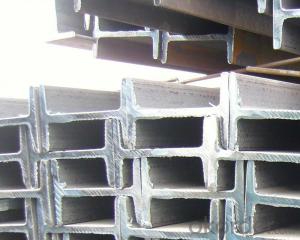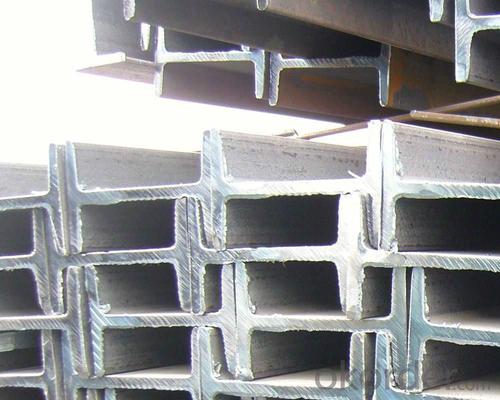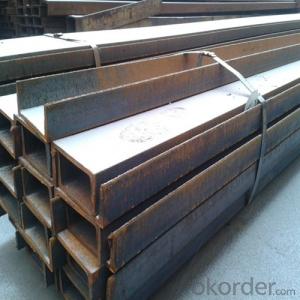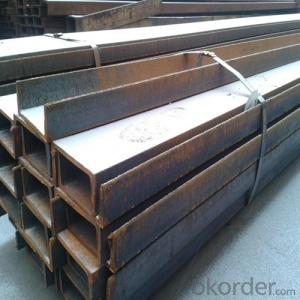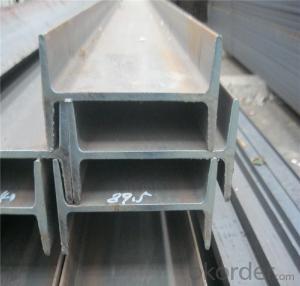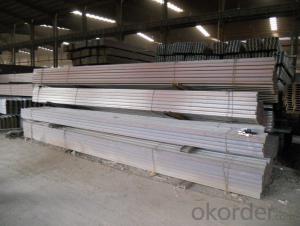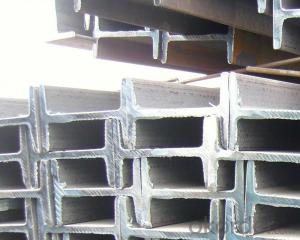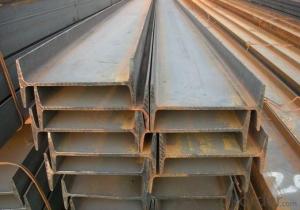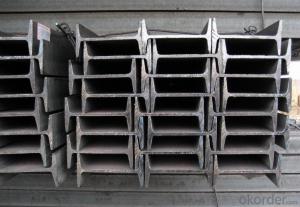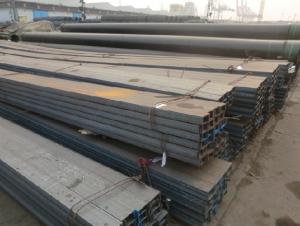High quality I beam GB Q235 or equivalent 80mm-270mm
- Loading Port:
- Tianjin
- Payment Terms:
- TT OR LC
- Min Order Qty:
- 25 m.t.
- Supply Capability:
- 20000 m.t./month
OKorder Service Pledge
OKorder Financial Service
You Might Also Like
IPE Details:
| Minimum Order Quantity: | Unit: | m.t. | Loading Port: | ||
| Supply Ability: | Payment Terms: | Package: | wire rod bundle |
Product Description:
Product Description:
Specifications of IPE Beam
1. Invoicing on theoretical weight or actual weight as customer request
2. Standard: EN10025, GB Standard, ASTM
3. Grade: Q235B, Q345B, SS400, ASTM A36, S235JR, S275JR
4. Length: 5.8M, 6M, 9M, 12M as following table
5. Sizes: 80mm-270mm
Dimensions(mm) | |||||
h | b | s | t | Mass Kg/m | |
IPE80 | 80 | 46 | 3.80 | 5.20 | 6.00 |
IPE100 | 100 | 55 | 4.10 | 5.70 | 8.10 |
IPE120 | 120 | 64 | 4.80 | 6.30 | 10.40 |
IPE140 | 140 | 73 | 4.70 | 6.90 | 12.90 |
IPE160 | 160 | 82 | 5.00 | 7.40 | 15.80 |
IPE180 | 180 | 91 | 5.30 | 8.00 | 18.80 |
IPE200 | 200 | 100 | 5.60 | 8.50 | 22.40 |
IPE220 | 220 | 110 | 5.90 | 9.20 | 26.20 |
IPE240 | 240 | 120 | 6.20 | 9.80 | 30.70 |
IPE270 | 270 | 135 | 6.60 | 10.20 | 36.10 |
Appications of IPE Beam
1. Supporting members, most commonly in the house raising industry to strengthen timber bears under houses. Transmission line towers, etc
2. Prefabricated structure
3. Medium scale bridges
4. It is widely used in various building structures and engineering structures such as roof beams, bridges, transmission towers, hoisting machinery and transport machinery, ships, industrial furnaces, reaction tower, container frame and warehouse etc.
Package & Delivery of IPE Beam
1. Packing: it is nude packed in bundles by steel wire rod
2. Bundle weight: not more than 3.5MT for bulk vessel; less than 3 MT for container load
3. Marks: Color marking: There will be color marking on both end of the bundle for the cargo delivered by bulk vessel. That makes it easily to distinguish at the destination port.
4. Tag mark: there will be tag mark tied up on the bundles. The information usually including supplier logo and name, product name, made in China, shipping marks and other information request by the customer.
If loading by container the marking is not needed, but we will prepare it as customer request.
5. Transportation: the goods are delivered by truck from mill to loading port, the maximum quantity can be loaded is around 40MTs by each truck. If the order quantity cannot reach the full truck loaded, the transportation cost per ton will be little higher than full load.
6. Delivery of IPE Beam: 30 days after getting L/C Original at sight or T/T in advance
Production flow of IPE Beam
Material prepare (billet) —heat up—rough rolling—precision rolling—cooling—packing—storage and transportation
- Q: What's the minimum specification for I-beam?
- I-steel whether ordinary or light, because the section size are relatively high and narrow, so the moment of inertia of section two of the spindle is larger, so it only can be directly used in the web plane bending member or the composition of lattice stress components. H section steel is a kind of economical and economical surface profile (other cold bending thin wall steel, pressed steel plate, etc.). Because of the reasonable cross-section shape, they can make steel more effective and improve the bearing capacity. Unlike ordinary I-beam, the flange of H steel is widened, and the inner and outer surfaces are usually parallel so that it is easy to connect with high strength bolts and other components. The size of the series is reasonable, the model is complete, easy to design and use.
- Q: How are steel I-beams inspected for quality control?
- Steel I-beams are inspected for quality control through a series of visual inspections, dimensional measurements, and non-destructive testing techniques. This may include checking for any visible defects, such as cracks, surface roughness, or uneven welds. Additionally, measurements are taken to ensure the beam's dimensions and tolerances are within the specified range. Non-destructive testing methods, such as ultrasonic testing or magnetic particle inspection, are also employed to detect any internal defects or discontinuities that may affect its structural integrity. Overall, a thorough inspection process is carried out to ensure that steel I-beams meet the required quality standards.
- Q: Can steel I-beams be used in hospitals or healthcare facilities?
- Certainly, hospitals and healthcare facilities can indeed utilize steel I-beams. These beams are widely employed in the construction sector owing to their robustness, endurance, and ability to bear heavy loads. In healthcare settings, where the preservation of the structure's safety and integrity is of utmost importance, steel I-beams are capable of providing the requisite support for the edifice. They are frequently incorporated into the assembly of floors, walls, and roofs, thereby ensuring the overall stability of the structure. Moreover, steel I-beams exhibit excellent resistance to fire, pests, and weathering, rendering them an exceptionally dependable choice for healthcare facilities that necessitate a durable and low-maintenance construction solution.
- Q: What are the different types of steel I-beam connections for lateral stability?
- There are several types of steel I-beam connections for lateral stability, including moment connections, shear connections, and bracing connections. Moment connections provide resistance against lateral forces by transferring moments between the beam and the supporting structure. Shear connections, on the other hand, resist lateral forces through the transfer of shear forces between the beam and the supporting structure. Bracing connections involve the use of braces or diagonal members to provide lateral stability by resisting forces in tension or compression. These various types of connections are crucial for ensuring the overall stability and structural integrity of steel I-beam systems.
- Q: Can steel I-beams be used in airport terminals?
- Indeed, airport terminals can utilize steel I-beams effectively. The construction industry frequently employs steel I-beams due to their robustness, longevity, and adaptability. They serve as a crucial structural support system, often employed to establish the framework for expansive, unobstructed areas like airport terminals. The remarkable load-bearing capacity of steel I-beams permits the creation of vast spans and spacious floor plans, which are indispensable in airport terminals. These features enable the accommodation of sizable crowds and provide flexibility for various amenities such as check-in counters, security zones, lounges, and retail spaces. Furthermore, steel I-beams possess the ability to endure harsh weather conditions and possess fire-resistant properties, rendering them an ideal choice for airport terminals that prioritize safety and security.
- Q: What are the different types of steel coatings used on I-beams?
- There are several different types of steel coatings commonly used on I-beams, each offering unique properties and benefits. Some of the most common types of steel coatings include: 1. Galvanized Coating: This is one of the most popular and widely used coatings for I-beams. Galvanized coating involves applying a layer of zinc to the surface of the steel. This coating provides excellent corrosion resistance, protecting the I-beams from rust and other forms of deterioration. Galvanized coatings are also known for their durability, making them ideal for outdoor and harsh environments. 2. Epoxy Coating: Epoxy coatings are applied to I-beams to provide enhanced protection against corrosion. These coatings are typically made from a combination of epoxy resins and a curing agent. Epoxy coatings offer excellent resistance to chemicals, abrasion, and impact, making them suitable for industrial and marine applications. 3. Powder Coating: Powder coating involves applying a dry powder to the surface of the I-beams, which is then cured under heat to create a protective layer. This coating provides excellent resistance to corrosion, chemicals, and UV radiation. Powder coatings also offer a wide range of color options, allowing for customization and aesthetic appeal. 4. Organic Coatings: Organic coatings, such as acrylics or urethanes, can be used to protect I-beams from corrosion and provide a decorative finish. These coatings are typically applied as a liquid and then cured to form a protective layer. Organic coatings offer good resistance to weathering and can be used in various environments. 5. Thermal Spray Coatings: Thermal spray coatings involve applying a layer of molten or semi-molten material onto the surface of the I-beams. These coatings can be made from various materials, including metals, ceramics, and polymers. Thermal spray coatings provide excellent protection against wear, corrosion, and high temperatures. It's important to note that the selection of a specific coating for I-beams depends on the intended application, environmental conditions, and desired performance characteristics. Consulting with coating experts or engineers can help determine the most suitable coating for a particular project.
- Q: How do engineers determine the appropriate size and type of steel I-beam for a project?
- Engineers determine the appropriate size and type of steel I-beam for a project through a detailed analysis of various factors. Firstly, they consider the structural requirements of the project, which includes the load-bearing capacity, span length, and anticipated loads such as dead loads (permanent) and live loads (temporary). To determine the required size of the I-beam, engineers perform structural calculations and utilize engineering principles, such as bending moment, shear force, and deflection analysis. These calculations help engineers understand the forces and stresses acting on the beam, allowing them to select an appropriate size that can safely support the anticipated loads without failing. Furthermore, engineers consider the type of steel I-beam based on the specific project requirements. Different steel grades offer varying strength, ductility, and resistance to corrosion. Engineers assess the environmental conditions, exposure to moisture, and potential chemical influences to select a steel type that can withstand these factors and maintain its structural integrity over time. In addition to structural considerations, engineers also take into account cost-effectiveness and availability of the steel I-beams. They aim to find a balance between meeting the project requirements and minimizing unnecessary expenses. This involves considering the standard sizes and shapes available in the market, ensuring that the chosen I-beam can be easily sourced and integrated into the project without significant delays or additional costs. Overall, the determination of the appropriate size and type of steel I-beam for a project is a meticulous process that requires careful consideration of the structural requirements, load calculations, material properties, and economic factors. Engineers employ their expertise, knowledge of engineering principles, and relevant design codes and standards to ensure the safe and efficient use of steel I-beams in construction projects.
- Q: Can steel I-beams be used for parking structures?
- Indeed, parking structures can utilize steel I-beams. In construction projects, steel I-beams are widely employed owing to their robustness and longevity. They possess the capability to withstand heavy loads, making them well-suited for parking structures that require accommodation for multiple vehicles. Moreover, the fabrication and assembly of steel I-beams are effortless, providing flexibility in both design and construction. By incorporating steel I-beams into parking structures, one can create wide, open spaces without the necessity of excessive columns or support structures, thereby maximizing available parking space. In summary, due to their structural integrity, cost-effectiveness, and ability to meet weight requirements, steel I-beams are a popular choice for parking structures.
- Q: Can steel I-beams be used in renovation or retrofitting projects?
- Certainly, steel I-beams are a viable option for renovation or retrofitting endeavors. Their robustness and durability make them a popular choice in the construction industry. They can be employed to provide supplementary reinforcement for existing structures, such as fortifying load-bearing walls or floors. Moreover, in renovation projects, steel I-beams are frequently utilized to establish spacious floor plans by replacing load-bearing walls with these beams to bear the weight above. Additionally, in retrofitting undertakings, steel I-beams can enhance and stabilize older buildings that were not initially engineered to withstand particular loads or forces. All in all, steel I-beams offer a versatile and efficient solution for a wide range of renovation or retrofitting projects.
- Q: Can steel I-beams be used in airport terminals or hangars?
- Yes, steel I-beams can be used in airport terminals or hangars. Steel I-beams are commonly used in construction due to their strength and durability. They are able to support heavy loads and provide stability to structures. In airport terminals or hangars, where large open spaces are necessary, steel I-beams can be used to create the framework for the roof and support the weight of the structure. Additionally, steel I-beams can be easily fabricated and assembled, making them a cost-effective choice for airport terminals or hangars.
Send your message to us
High quality I beam GB Q235 or equivalent 80mm-270mm
- Loading Port:
- Tianjin
- Payment Terms:
- TT OR LC
- Min Order Qty:
- 25 m.t.
- Supply Capability:
- 20000 m.t./month
OKorder Service Pledge
OKorder Financial Service
Similar products
Hot products
Hot Searches
Related keywords
